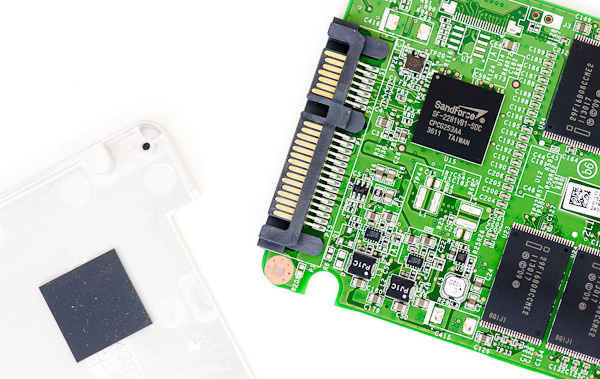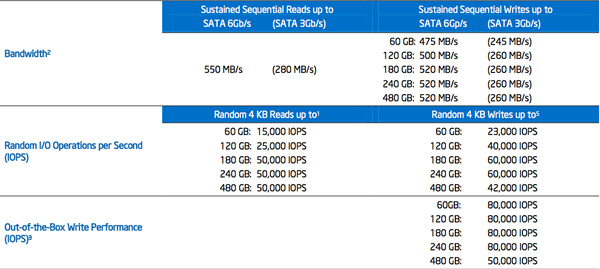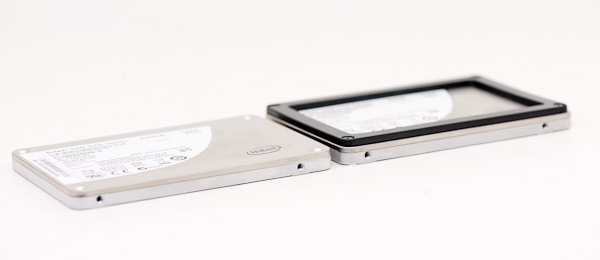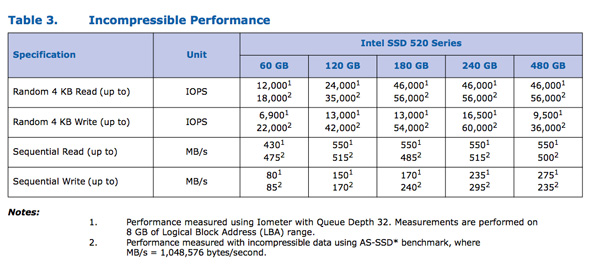Intel SSD 520 Review: Cherryville Brings Reliability to SandForce
by Anand Lal Shimpi on February 6, 2012 11:00 AM ESTThe Intel SSD 520
Intel sent us a 240GB and 60GB SSD 520 for review, but the performance specs of the entire family are in the table below:
The Intel SSD 520 is available in both 9.5mm and 7mm versions, with the exception of the 480GB flavor that only comes in a 9.5mm chassis. The 520's uses Intel's standard 7mm chassis with a 2.5mm removable plastic adapter that we've seen since the X25-M G2. The plastic adapter allows the drive to fit in bays designed for 9.5mm drives. Note that Intel doesn't ship shorter screws with the 9.5mm drives so you can't just remove the plastic adapter and re-use the existing screws if your system only accepts a 7mm drive.
Inside the drive we see the oh-so-familiar SandForce SF-2281 controller and Intel 25nm MLC NAND. The controller revision appears unchanged from other SF drives we've seen over the past year. The PCB design is unique to the 520, making it and the custom Intel firmware the two noticeable differences between this and other SF-2281 drives.

Intel uses the metal drive chassis as a heatsink for the SF-2281 controller
The SF-2281 Controller
I've explained how the SF-2281 works in the past, but for those of you who aren't familiar with the technology I'll provide a quick recap. Tracking the location of data written to an SSD ends up being one of the most difficult things a controller has to do. There are a number of requirements that must be met. Data can't be written to the same NAND cells too frequently and it should be spread out across as many different NAND die as possible (to improve performance). For large sequential transfers, meeting these (and other) requirements isn't difficult. Problems arise when you've got short bursts of random data that can't be combined. The end result is leaving the drive in a highly fragmented state that is suboptimal for achieving good performance.
You can get around the issue of tracking tons of data by simply not allowing small groups of data to be written. Track data at the block level, always requiring large writes, and your controller has a much easier job. Unfortunately block mapping results in very poor small file random write performance as we've seen in earlier architectures so this approach isn't very useful for anything outside of CF/SD cards for use in cameras.
A controller can rise to the challenge by having large amounts of cache (on-die and externally) to help deal with managing huge NAND mapping tables. Combine tons of fast storage with a fast controller and intelligent firmware and you've got a good chance of building a high performance SSD.

SandForce's solution leverages the work smart not hard philosophy. SF controllers reduce the amount of data that has to be tracked on NAND by compressing any data the host asks to write to the drive. From the host's perspective, the drive wrote everything that was asked of it, but from the SSD's perspective only the simplest representation of the data is stored on the drive. Running real-time compression/de-duplication algorithms in hardware isn't very difficult and the result is great performance for a majority of workloads (you can't really write faster than a controller that doesn't actually write all of the data to NAND). The only limit to SandForce's technology is that any data that can't be compressed (highly random bits or data that's already compressed) isn't written nearly as quickly.
Intel does a great job of spelling out the differences in performance depending on the type of data you write to the SSD 520, but it's something that customers of previous Intel SSDs haven't had to worry about. Most client users stand to benefit from SandForce's technology and it's actually very exciting for a lot of enterprise workloads as well, but you do need to pay attention to what you're going to be doing with the drive before deciding on it.
The Intel SSD Toolbox
The Intel SSD 520 works flawlessly with the latest version of Intel's SSD Toolbox. The toolbox allows you to secure erase the drive from within Windows, and it also allows you to perform firmware updates and pull SMART info from the drive. Unlike other SandForce toolboxes, Intel's software works fine with Intel's RST drivers installed.

The Test
| CPU | Intel Core i7 2600K running at 3.4GHz (Turbo & EIST Disabled) - for AT SB 2011, AS SSD & ATTO |
| Motherboard: | Intel DH67BL Motherboard |
| Chipset: | Intel H67 |
| Chipset Drivers: | Intel 9.1.1.1015 + Intel RST 10.2 |
| Memory: | Corsair Vengeance DDR3-1333 2 x 2GB (7-7-7-20) |
| Video Card: | eVGA GeForce GTX 285 |
| Video Drivers: | NVIDIA ForceWare 190.38 64-bit |
| Desktop Resolution: | 1920 x 1200 |
| OS: | Windows 7 x64 |























138 Comments
View All Comments
Beenthere - Wednesday, February 8, 2012 - link
Unfortunately Intel just like OCZ, Corsair and most all the rest of the SSD purveyors have adopted the Asus Biz model where you ship it today and hope you can fix it tomorrow when people find it's got lots of defects.It's totally unscrupulous to ship products with defects that have not been corrected due to a proper validation procedure not being implemented because the mfg. was more interested in rushing the product to market for quick profits or they are simply incompetent.
If you bought a new car and the brakes didn't function you'd have a Helleva lawsuit. If the car's trans only worked on Wednesdays and Fridays, you'll have a Helleva lawsuit. If the car maker only responded to the problems by replacing the defective product with another defective product - yup, you'd have a Helleva lawsuit.
This is how a lot of SSD companies are responding the defects in consumer grade SSDs.
NitroWare - Thursday, February 9, 2012 - link
I understand what your saying but ASUS is a company who do no skimp on overall validation of their products. This can be objectively proven by comparing their BIOS changelogs and QVL lists against a tier 2 manufacturer.Enthusiast products are touch and go especially when high speeds or aggressive compatibility is involved. You can not have it both ways wether its a SSD, Mobo, VGA or even a car
There are 'stable' products and there are 'aggressive' products (esp mobos and vga)
The stable products, Intel Desktop Boards, Supermicro server/workstation boards, DELL/HP Prebuilts and some basic generic motherboards are BORING to part of the target market who are being targeted by cheap and fast SSDs.
Do dell even validate many different SSD controller on their desktop and portables?
There are firms who have SSD in Mission Critical apps. Either Team Lotus or Red Bull F1 I forget who switched all their pitcrew laptops to SSD due to vibration from the F1 engines.
Can you imagine what would happen if an engineer experiencing a BSOD such a frantic scenario ?
The target market want the bleeding edge and many vendors are forced to comply by playing the numbers game or including technical features on their products which have no benefit (eg extra power sockets) except as a marketing bulletpoint targeted to enthusiasts and matching their competition.
Many would be surprised how many features on components such as motherboards or power supplies are stuck on simply due to customer (OEM) requests or technical marketing/competitive demands.
There are parts of the enthusiast community, especially extreme and sub zero overclockers who don't care about 'stability' or who do not understand what the true meaning of this is. Their definition is stability is how much LN2 they can pour by balancing one hand with another hand on their mouse in vain effort to get their overclock stable.
Manufs of cheaper devices have never really cared about support and many have a small handful of design engineers who are already overworked. This has not changed in twenty years of PC add on devices.
It is a shame that some 'brand names' currently have issues really, a damm shame.
vol7ron - Tuesday, February 7, 2012 - link
One of Intel's biggest advantages was the spread spectrum of their wear-leveling controller. I may have missed it, but I didn't see any mention of it in the article.It would be nice if they could have combined the SF-2281 with their own controller to give a fast, controller that was spread evenly across the NAND, to further increase its shelf-life. Maybe that would be too costly, or maybe it wasn't needed, but I'm interested to hear what they have to say.
vol7ron
Sufo - Wednesday, February 8, 2012 - link
So, will the 720 be based on SF-2000? How far away is that?I'm soon to be building an enterprise server... are these Intel drives (5xx or 7xx) really up to enterprise load? Unlike many people, being able to pick something like the 710/720 would be a huge cost _saving_ - it seems to me that approved drives such as the HP ones cost 10x more than even these Intel drives.
On a side note, since Apple's acquisition of Anobit, is it safe to say the Genesis 2 is on hold?
Beenthere - Wednesday, February 8, 2012 - link
The story title is really inappropriate considering there is no proof that the 520 is any more reliable than other SSDs. There are even reports already of BSOD on the 520 drives at Intel's customer support forums.Wolfpup - Wednesday, February 8, 2012 - link
No question, BUT I'd still pick my Intel 320 over the 520. I still trust Intel's controller more, and the 320 is the only drive I know of that has built in hardware encryption. Completely awesome! I'm sure there must be other drives that do too, but that alone would have me picking the 320, and then when you consider I trust it more anyway, and it's a bit cheaper...Wish the 600GB 320 wasn't over $1000 though :-D Oh well, my 300GB one is okay, and my Seagate Momentus XTs are great too.
Beenthere - Wednesday, February 8, 2012 - link
Already reports of 520 BSOD at Intel support... :(Galvin - Friday, February 10, 2012 - link
I could get a BSOD and report in intel forums too. All I have to do is disable AHCI drivers in windows and reboot. Get a BSOD. I think the issue is not the drive but the user not setting their bios up correctly or windows correctly or both.Galvin - Friday, February 10, 2012 - link
Just wanted to update if you read that post. He fixed the problem. It had nothing to do with the drive. People want to hate intel just cause they're intel.mbryans - Thursday, February 9, 2012 - link
Intel SSD 520 Series 480 GB: random 4 KB writes up to (only) 42,000 IOPS? While for 240 GB could reach 60,000 IOPS. The greater capacity should be faster.